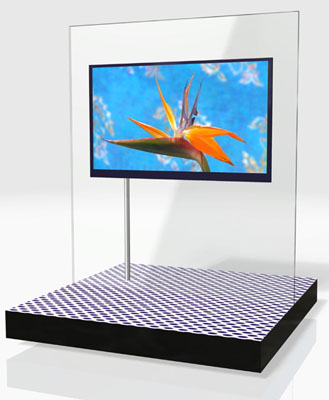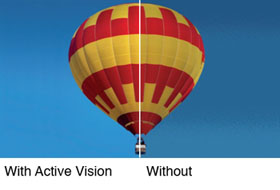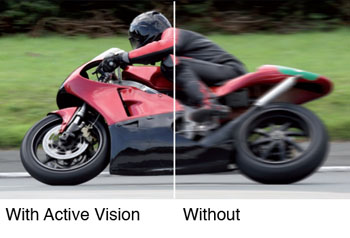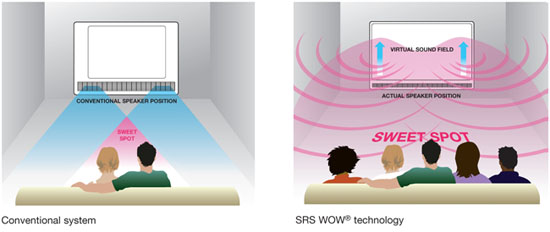Technology
The surface conduction electron emitter apparatus consists of a thin slit across which electrons tunnel when excited by moderate voltages (tens of volts). When the electrons cross electric poles across the thin slit, some are scattered at the receiving pole and are accelerated toward the display surface by a large voltage gradient (tens of thousands of volts) between the display panel and the surface conduction electron emitter apparatus. Canon Inc. working with Toshiba uses inkjet printing technology to spray phosphors onto the glass. The technology has been in development since 1986.
History
Canon began SED research in 1986 and, in 2004, Toshiba and Canon announced a joint development agreement originally targeting commercial production of SEDs by the end of 2005. The 2005 target was not met, and several new targets since then have also slipped by. This failure to meet mass-production deadlines goes as far back as 1999, when Canon first told investors of its intentions to immediately begin mass-producing the technology. The lack of tangible progress has worried many investors and has prompted many critics. One critic called SED “the best display technology you’ve ever seen that may be stillborn.”[1] During the 2006 Consumer Electronics Show in Las Vegas, Nevada, Toshiba showed working prototypes of SEDs to attendees and indicated expected availability in mid-to-late 2006.[2] Toshiba and Canon again delayed their plan to sell the television sets to the fourth quarter of 2007.[3] At the 2007 Consumer Electronics Show, no SED displays were to be found on the show floor. This led many analysts to speculate that the technology would never reach the consumer market.[4]
In October 2006, Toshiba's president announced the company plans to begin full production of 55-inch SED TVs in July 2007 at its recently built SED volume-production facility in Himeji.[5]
In December 2006, Toshiba President and Chief Executive Atsutoshi Nishida said Toshiba is on track to mass-produce SED TV sets in cooperation with Canon by 2008. He said the company plans to start small-output production in the fall of 2007,[6] but they do not expect SED displays to become a commodity and will not release the technology to the consumer market because of its expected high price, reserving it solely for professional broadcasting applications.[7]
Nano-Proprietary Lawsuit
Also in December of 2006, it was revealed that the delays in SED TV mass production were caused by litigation between Applied Nanotech, a subsidiary of Nano-Proprietary, and Canon. Nano-Proprietary claims that Canon broke an exclusivity agreement by sharing information related to electron emissions from carbon nanotubes with Toshiba. The litigation has been reportedly ongoing since April of 2006.
On January 12, 2007, Toshiba announced[8] an agreement by which Canon will purchase all of Toshiba's outstanding share of the SED joint venture, in order to satisfy Nano-Proprietary's complaints. This is also expected to prevent the litigation from dragging on in American courts.[9] The company must purchase 50% of Toshiba shares to produce SED TVs on its own.[10] Canon was still planning a release of SED displays in Japan during the 4th quarter of 2007, while 'reassessing' its future mass-production plans for SED panels.
On February 22, 2007, Federal Judge Samuel Sparks, with the U.S. District Court for the Western District of Texas, ruled in a summary judgment that Canon violated its agreement with Texas-based Nano-Proprietary by forming a joint television venture with Toshiba.[11] However, on May 3, 2007, a jury ruled that no additional damages beyond the $5.5m fee for the original licensing contract were due.[12][13]
On May 25, 2007, Canon again announced due to prolonged litigation, it will postpone the launch of SED televisions, originally planned for October-December of 2007. The company said it will announce a new launch date in the future.[14]
Advantages
- 50,000:1 contrast ratio. According to IGN at the 2006 CES show, Toshiba's final versions of SEDs will ship with a contrast ratio of 100,000:1.
- 0.2 milliseconds response time.
- Brightness of 450 cd/m2.[15]
Disadvantages
- As with any phosphor-based technology, SED may also be susceptible to screen burn-in. This was a constant problem for people using CRT television monitors for security camera systems. Early plasmas also had this problem, but with phosphor development, the problem has largely been reduced.
 Similar to a CRT, the display is created with electrons that collide with a phosphor-coated screen. CRTs use a single electron gun to emit the particles that create the display. The one electron gun essentially draws the screen by passing all of the electrons to the screen. Since the electron gun has to cover the entire screen, the set tends to be deep, although some slimmer sets are coming to market. Additionally, since the electron gun is constantly sending particles to the entire screen, it tends to be a heavy consumer of power.
Similar to a CRT, the display is created with electrons that collide with a phosphor-coated screen. CRTs use a single electron gun to emit the particles that create the display. The one electron gun essentially draws the screen by passing all of the electrons to the screen. Since the electron gun has to cover the entire screen, the set tends to be deep, although some slimmer sets are coming to market. Additionally, since the electron gun is constantly sending particles to the entire screen, it tends to be a heavy consumer of power. SED technology applies the electron-phosphorus concept, but radically changes one key element: the electron mechanism. Instead of a single electron gun, SED sets have one electron emitter for each pixel. This brings two key CRT advantages to the flat panel world. Less power is needed because the electrons don't need to travel as far. Since the electrons are close to the display surface, the set is much slimmer than a CRT set, as well. If that doesn't get you as excited as a charged electron, then just wait, there's more!
SED technology applies the electron-phosphorus concept, but radically changes one key element: the electron mechanism. Instead of a single electron gun, SED sets have one electron emitter for each pixel. This brings two key CRT advantages to the flat panel world. Less power is needed because the electrons don't need to travel as far. Since the electrons are close to the display surface, the set is much slimmer than a CRT set, as well. If that doesn't get you as excited as a charged electron, then just wait, there's more! JVC LT-42X898
JVC LT-42X898
 LG 47LBX
LG 47LBX Panasonic TH-42PZ700U
Panasonic TH-42PZ700U Mitsubishi WD-65833
Mitsubishi WD-65833 Westinghouse Digital TX-47F430S
Westinghouse Digital TX-47F430S
 Samsung HP-S4273
Samsung HP-S4273














 DETAIL
DETAIL
 MOVEMENT
MOVEMENT



